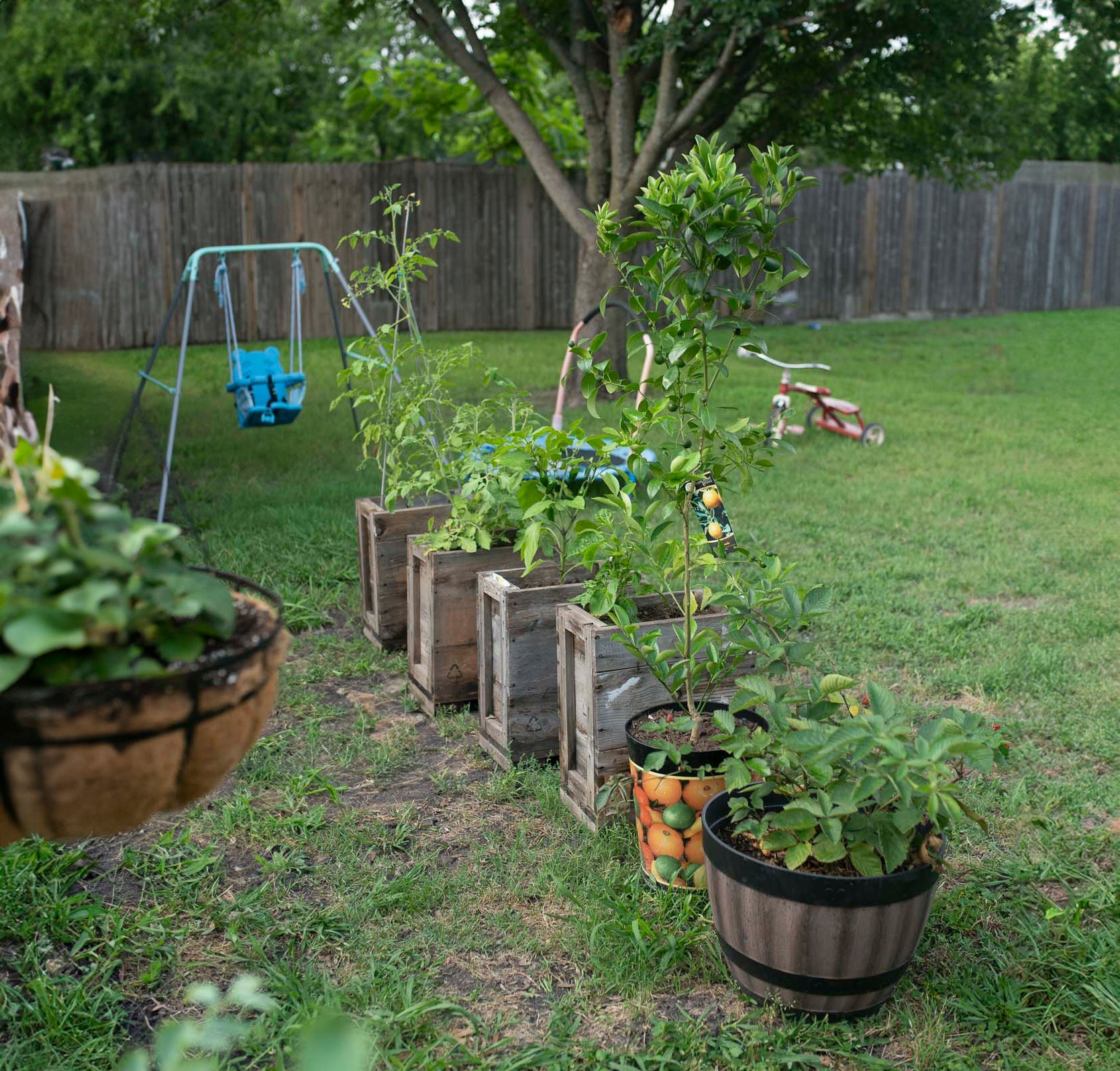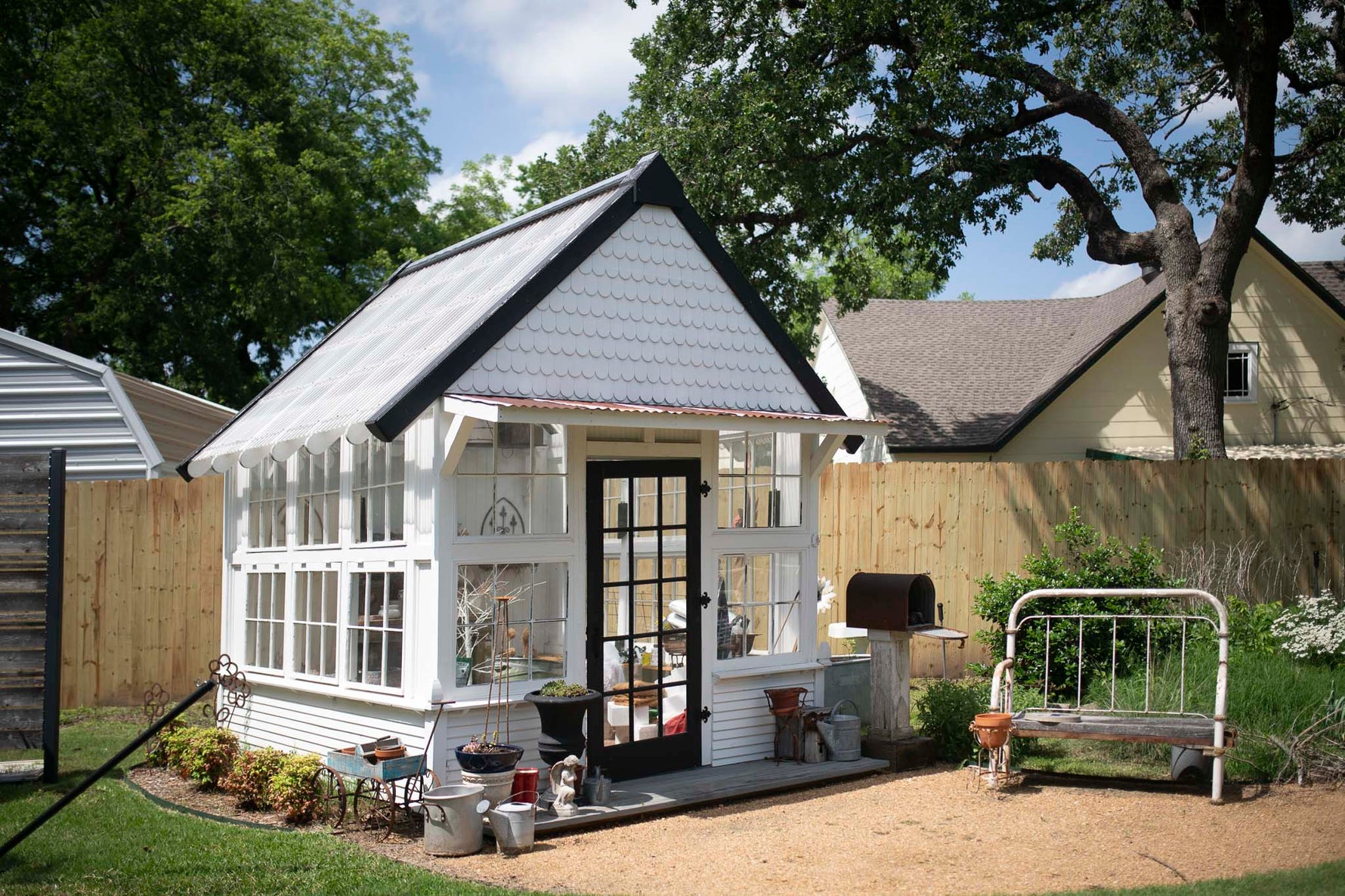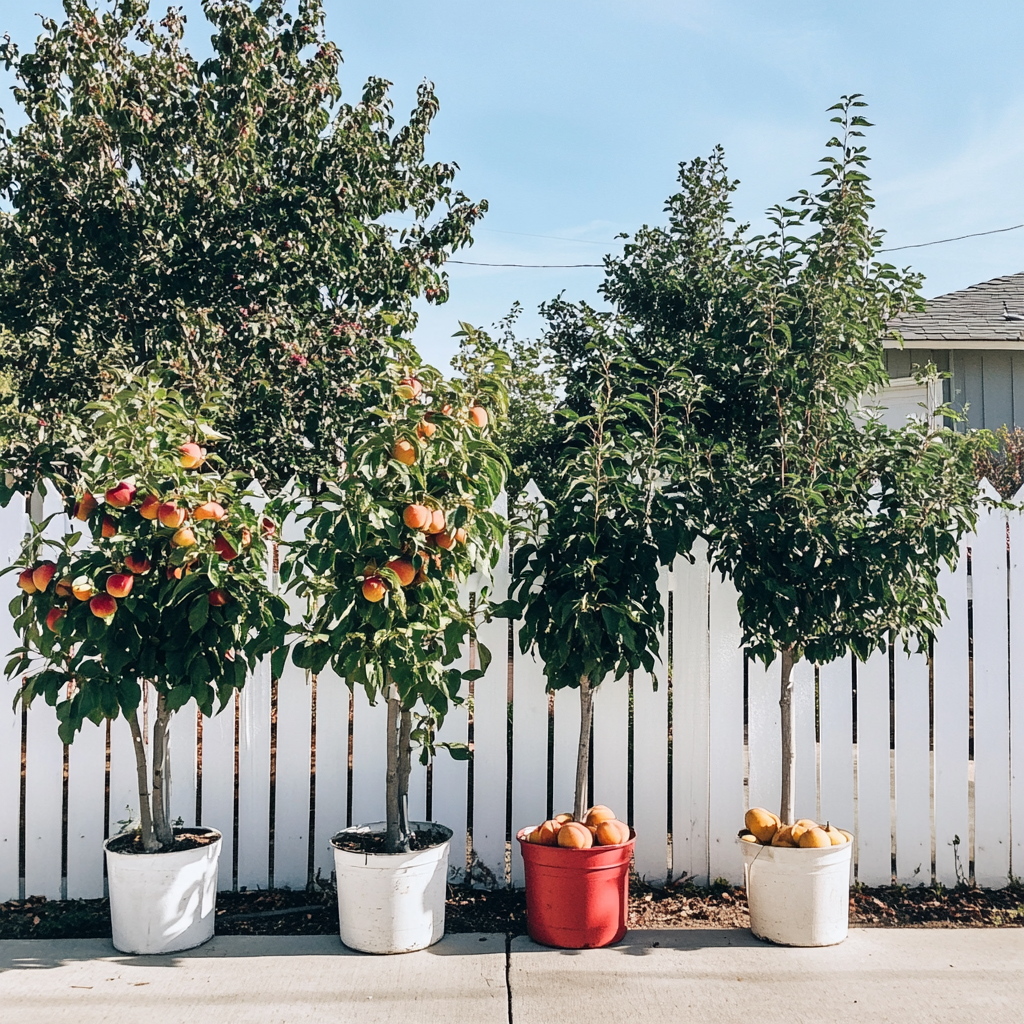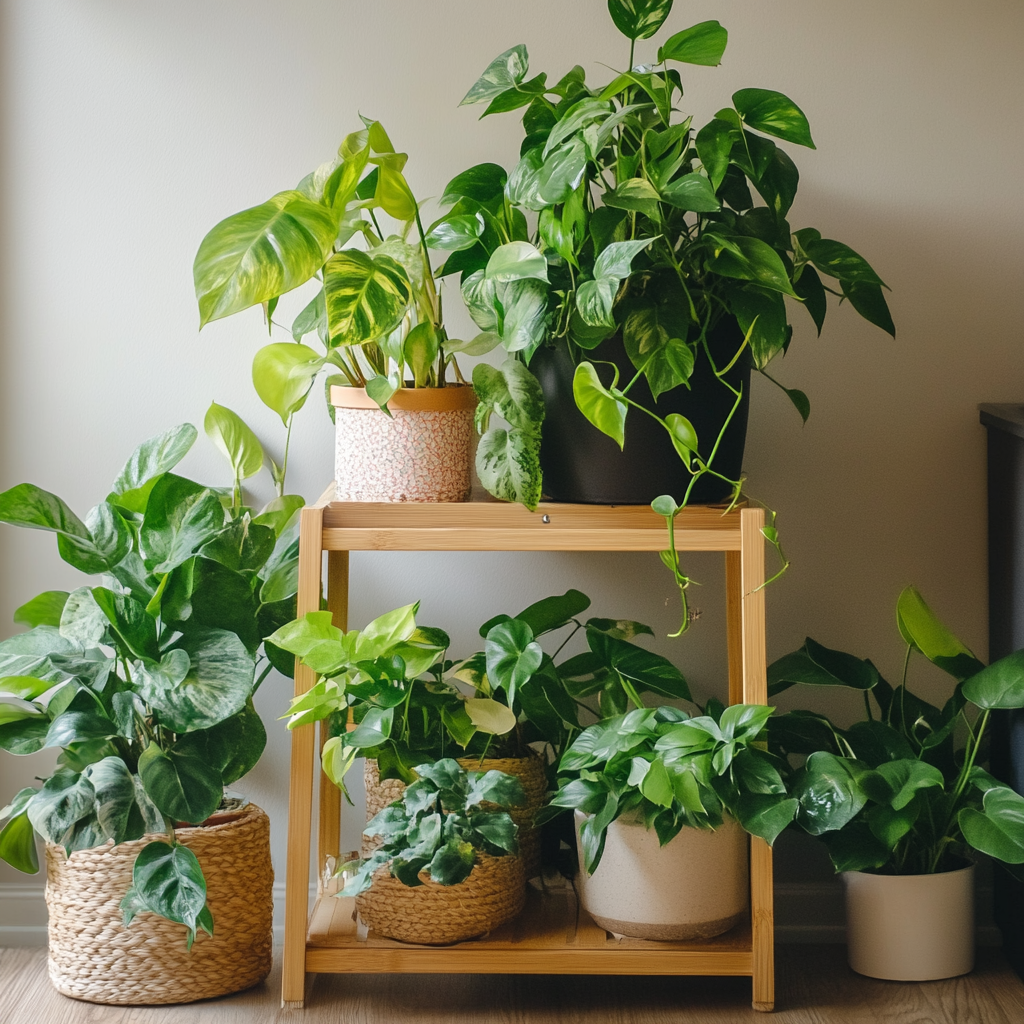News

News
Backyard Abundance: A Family Garden Full of Heart
by Emily Bussey on May 20, 2025
Backyard Abundance: A Family Garden Full of Heart
By Rooted in Kaufman
If you ever find yourself daydreaming about a peaceful, productive backyard that brings generations together, Chris and Chelsea Jaremko’s garden is what that dream looks like. Nestled in their backyard, this edible oasis is more than just a patch of plants—it’s a place where strawberries are treasures, peach trees are milestones, and the grandkids always know where to find something sweet.
🌱 Growing Runs in the Family
Chris traces his gardening roots back to childhood, when his dad would till up a backyard plot for peppers, tomatoes, green beans, and okra. “It’s like it’s embedded in my DNA,” he says. That early exposure laid the foundation for what he and Chelsea are now cultivating—literally and figuratively—with their own family.
Chelsea’s first brush with gardening started when they bought their home and brought in a trailing vine plant that quickly took over the patio. “It was stressful,” she laughs, “but now it’s like, we can’t imagine not having plants.”
🍓 Why Peach Trees and Strawberries?
The couple’s current favorites? Strawberries and a peach tree. The strawberries have been a journey—early plants didn’t thrive, but with improved soil, better fertilizer, and a lot of trial and error, they’re now harvesting the best crop yet.
Chelsea picked out the peach tree for its beauty and resilience. “Peach trees can handle our winters,” Chris adds. “We love the idea of having homegrown fruit that sticks around year after year.”
🧒 A Garden Built for Grandkids
While the garden started with the couple’s own passions, it has naturally evolved into a haven for their grandkids. “We definitely had them in mind,” says Chelsea. Strawberries are a favorite snack, and the kids love discovering new things—sometimes a bit too early. “Our grandson called a tomato an apple,” Chris laughs. “And they love picking lemons even if they’re not quite ready.”
Their oldest grandchild has even helped plant and water the blueberries, and there's talk of a native wildflower section just for pollinators. “We’re planning a part of the yard we don’t mow for a while—just let the wildflowers take over,” Chris explains.
🌸 Lessons in Soil, Patience, and Surprise Dill
They’ve had their fair share of wins and setbacks. Dill, surprisingly, has thrived. “That thing went crazy,” Chris says. “I found fish fertilizer at Walmart and it changed the game.”
Strawberries, on the other hand, remain their trickiest plant. They’ve gotten better each year, but they’re still chasing that dream crop.
The couple has learned to research each plant’s soil needs and stay away from generic mixes. “Everything is unique,” says Chelsea. “You’ve gotta give each plant what it wants.”
🌼 What’s Next? Native Plants and Pollinators
Looking forward, Chris and Chelsea are excited to integrate more native wildflowers, both for the bees and for the Blackland Prairie ecosystem their yard sits on. “We want to use what naturally thrives here,” Chris says. “And if we can build soil with our own earthworms and compost, even better.”
They hope to eventually turn part of the yard into a native pollinator garden and line their back fence with flowers. “I want it to be full of blooms,” Chelsea says.
🪨 A Garden with a Sparkle
It’s not just plants that grow in Chelsea’s garden—her love of rocks and crystals brings another layer of beauty and personality to the space. A dedicated rockhound, she’s built a small rock garden using treasures collected from her travels, including crystals from Arkansas and Oklahoma and even geodes she found herself in the Oklahoma hills. The sparkling stones are nestled into flower beds and corners of the yard, catching the light and adding a touch of magic among the greenery. It’s a reflection of Chelsea’s curiosity and connection to the earth—and yet another reason their backyard feels so personal and one-of-a-kind.
💡 Advice for Families Starting Their Garden
When asked what advice they’d give someone wanting to build a small, kid-friendly garden, their answer is simple:Start with fruits and flowers.“Choose plants you can eat and see grow. There’s nothing like that feeling when something starts thriving.”
Chris adds, “When you’ve been struggling with a plant and it finally starts to take off—that’s the best feeling in the world.”

News
A Garden Grows in Kaufman: Cottagecore Dreams and Coneflower Love
by Emily Bussey on May 07, 2025
A Garden Grows in Kaufman: Cottagecore Dreams and Coneflower Love
Last week, we had the joy of stepping into a local gardener’s personal paradise—and what we found was more than just a backyard. It was a living, blooming love letter to Texas native plants, vibrant color, and the peace that only gardening can bring. Cindy Rich welcomed us into her world, where coneflowers reign, butterflies are welcome guests, and every season brings something new to admire.
Coneflowers, Salvias & the Joy of Trial and Error
“I love coneflowers,” Cindy says with a smile, pointing out her collection of cream, red, and yellow varieties. “They’re not quite as hardy as the classic pink, but they do well.” Her garden is full of similar success stories—plants that thrive after a little patience and experimentation.
She speaks warmly about salvia, yarrow, and Black-eyed Susans, which are all making a strong comeback in her beds. “Some things I’ve tried didn’t do well, but then others just took off! It’s a lot of trial and error.”
Cottagecore, the Texas Way
Cindy’s gardening approach leans into that dreamy, layered “cottagecore” vibe—with a practical Texas twist. “I try to mix it up so I always have something blooming,” she says. “And I like to pack it in—that way I don’t have to weed as much!”
Her go-to plants for that natural, ever-changing look include:
Coneflowers (especially the red and cream types)
Yarrow in white, yellow, and red
Salvias of all kinds
Black-eyed Susans
Pink Muhly Grass
Lantana (when it’s happy)
Pink Muhly Grass, she says, is the star of the fall. “They get big, fluffy pink plumes. They’re absolutely stunning. I have them everywhere!”
Planting with Pollinators in Mind
This garden doesn’t just look good—it supports local pollinators, too. Cindy makes space for butterflies by growing fennel each year—not for cooking, but for the caterpillars.
“Who eats fennel? Nobody. But the swallowtails love it.”
She’s had chrysalis after chrysalis appear on her plants and gets a thrill every time butterflies flutter through her yard. There’s also a giant purple hyacinth bean vine that trails up an arbor and spreads with wild abandon—“It’s like a weed almost, but gorgeous,” she laughs.
Tips from a Backyard Pro
When asked how she plans out her garden, Cindy is refreshingly honest: “It’s mostly trial and error. I move stuff if it’s not happy.” She pays attention to sunlight, reads plant tags, and isn’t afraid to shift things around—sometimes three times—until they’re thriving.
“Sometimes plants don’t get big their first year, then suddenly they explode and cover everything!”
Her biggest challenge? Weeds. “We’ve tried a lot—Roundup, pulling—but they always come back.” Still, she says, they manage to get it done every year.
For the Love of Gardening
Cindy’s garden didn’t happen overnight. They bought the house in 2020, right before the world shut down. After a year and a half of renovations, she finally turned her attention to the yard. Today, it’s a peaceful haven filled with beauty, butterflies, and a whole lot of heart.
“I think that’s when God speaks to me the most—when I’m out in the garden and everything slows down.”
Inspired to start your own Texas cottagecore garden?
Come visit us at Rooted in Kaufman! We’ve got a huge selection of native perennials, colorful hanging baskets, shade trees, and even houseplants we grow ourselves—so you can plant with confidence. Ask us about pollinator-friendly plants and get expert advice from real gardeners who love what they do.
Follow us on Facebook to see more garden tours and get local planting inspiration!

News
A Beginner’s Guide to Fruit Trees in North Texas
by Emily Bussey on Apr 21, 2025
🍑 A Beginner’s Guide to Fruit Trees in North Texas
By Rooted in Kaufman
If you’ve been thinking about planting a fruit tree (or a few!) in your yard, now’s the perfect time to get growing. At Rooted in Kaufman, we carry a wide variety of fruit trees that are well-suited to North Texas—and many of them are already mature and ready to thrive in your garden.
Whether you're looking to grow peaches, pears, figs, or even almonds, this guide will walk you through our most popular options, what to expect as they grow, and how to keep them healthy and productive.
🌳 What Types of Fruit Trees Do We Carry?
We’ve got a little bit of everything! Some of our current selection includes:
Peaches
Apricots
Pomegranates
Nectarines
Plums
Pears
Persimmons
Figs
Apples
Loquats
Guavas
Cherries
Pecans & Almonds
Many of our almond trees are already producing little fruits, and they’ve bloomed beautifully this spring!
🍑 Our Most Popular Picks Right Now
Our customers are especially loving:
Peaches – Always a fan favorite for their sweet fruit and low-maintenance needs.
Figs – These are flying off the shelves thanks to their unique look and hardy nature.
Apples, Apricots, and Nectarines – Classic options that do great in Texas soil.
🌞 Best Fruit Trees for North Texas
Looking for something that’ll do well in your North Texas yard long-term? These varieties are tried-and-true favorites:
Peaches
Pears
Figs
We hear from customers all the time who have had the same fruit tree in their yard for 20+ years—and they’re still producing!
⏳ How Long Until You See Fruit?
Most fruit trees take 3 to 5 years to start producing, which is why we sell ours in 5-gallon pots—they’re already in that mature, fruit-ready window. You may even see fruit starting to grow when you visit the nursery!
💡 Pro tip: If you plant a tree this year, remove the first round of fruit. This helps the tree focus on root growth, setting it up for long-term success and bigger harvests later.
🌱 How to Care for Your Fruit Trees
Sunlight:All fruit trees need full sun, ideally 8+ hours per day.
Watering:
While in pots: Daily watering
Just planted in-ground: Every other day, depending on size
During peak summer: Likely daily or even twice a day
As they get established: You can taper off watering, especially outside of summer
Maintenance:Most fruit trees are low-maintenance once established, but don’t skip annual pruning!Plan to prune in late winter (around February) to keep your tree shaped well and ensure good airflow.
🌸 Staff Favorite: Patio Peaches
One of our favorite finds right now? Dwarf Patio Peaches.
Only grow about 6 ft tall and 5 ft wide
Gorgeous weeping canopy
Covered in stunning blooms in spring
Produces full-sized peaches on a compact tree—perfect for small yards or container gardens
🛒 Ready to Grow Your Own?
Come visit us at Rooted in Kaufman to browse our full selection of fruit trees. Our team is happy to help you find the perfect match for your space—and we’ll make sure you leave with tips for long-term success.

News
Understanding Light Requirements for Houseplants
by Emily Bussey on Apr 21, 2025
🌞 Understanding Light Requirements for Houseplants
A Beginner’s Guide to Giving Your Plants the Right Amount of Light
If you’ve ever asked yourself, “Am I giving my plant enough light?”—you’re not alone. Understanding houseplant light requirements is one of the most important steps to keeping your indoor jungle healthy and thriving. The good news? You don’t need a greenhouse to grow happy plants—just a little insight into what kind of light your space offers and what your plants really need.
💡 The 3 Main Light Levels for Houseplants
Houseplants are generally grouped into three categories based on how much light they need:
🌑 Low Light
These plants can tolerate low light conditions like corners, hallways, or spots far from windows. Great low light plants:
ZZ Plant (Zamioculcas zamiifolia), including the sleek Raven ZZ variety
Spider Plant (also called Airplane Plant)
Aglaonema
Dieffenbachia
Rubber Tree
Moonshine Sansevieria
Whale Fin Sansevieria
Cordyline
Pothos
Philodendron Cordatum
🌤️ Medium Light
Medium light means your plant gets filtered sunlight for part of the day or is placed in a bright room not directly next to a window. Great medium light plants:
Pothos
Philodendron
Dieffenbachia
Pepermoia
☀️ High Light
These plants love the spotlight—literally. They need lots of direct or bright indirect sunlight to stay happy. Great high light plants:
Fiddle Leaf Fig
Ponytail palm
Jade
Aloe Vera
Bird of Paradise
🔍 Light Types Explained
Not all light is created equal! Here's what each type really means:
☀️ Direct Sunlight The sun’s rays hit the plant with no obstruction—like sitting on a windowsill facing south or west.
🌞 Bright Indirect Light Sunlight that’s filtered or bounced around a room, perfect for plants placed a few feet from a sunny window or behind a sheer curtain.
🌤️ Medium Light A balance between light and shade. Often found in east-facing rooms or near shaded windows.
🌑 Low Light The dimmest setting—think interior spaces with minimal or no natural light. Plants here should be real troopers!
🧪 How to Find the Right Light for Your Plant
🔍 Research Your Plant: Each plant is unique—look up its ideal conditions before choosing its spot.
👀 Observe Your Plant: Signs of not enough light include pale or yellowing leaves, drooping, and leggy stems.
🔁 Rotate Regularly: Just like us, plants don’t want a one-sided tan. Give them a turn every few weeks so all sides grow evenly.
💡 Consider Grow Lights: Not enough sun? No problem. Grow lights can give your plant the boost it needs.
🌱 Final Thoughts
Finding the perfect light for your houseplants doesn’t have to be complicated. A little observation and experimentation go a long way. Whether your space is bright and sunny or a bit on the shady side, there’s a plant out there that’ll love your home just the way it is.
